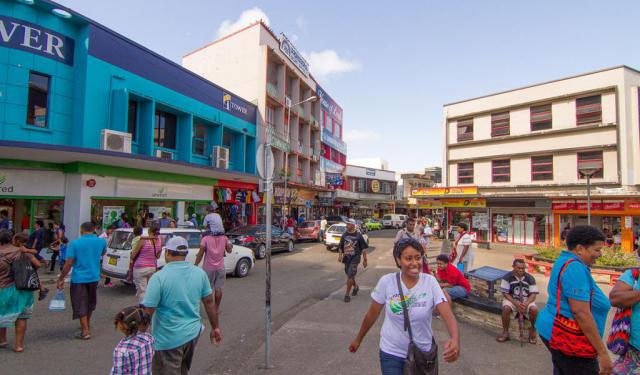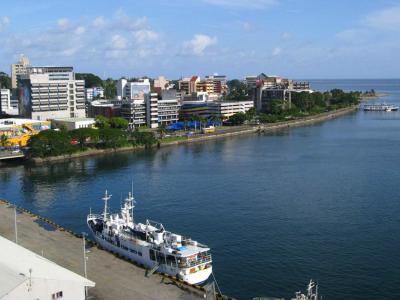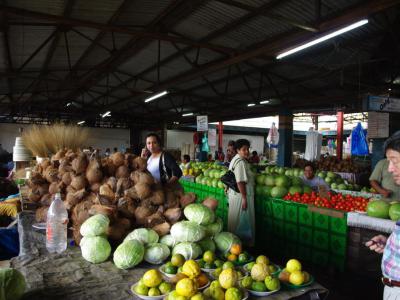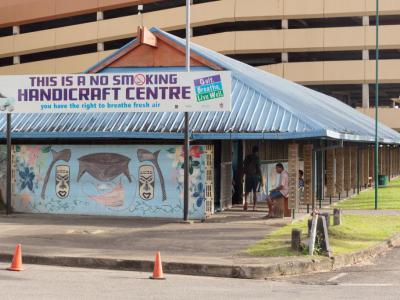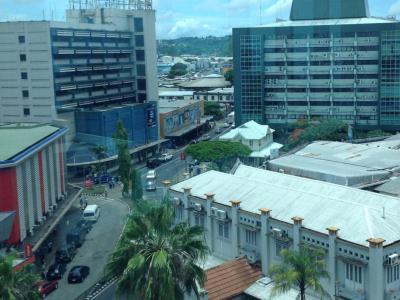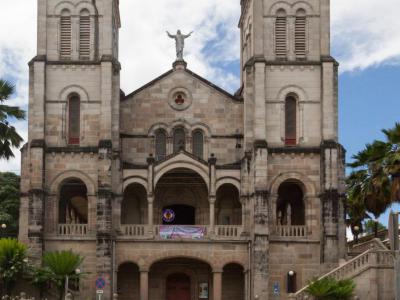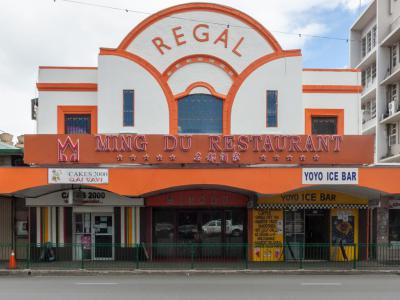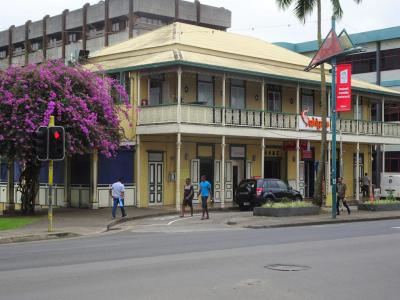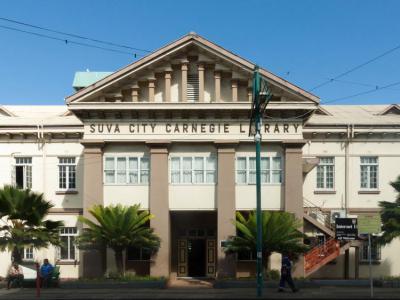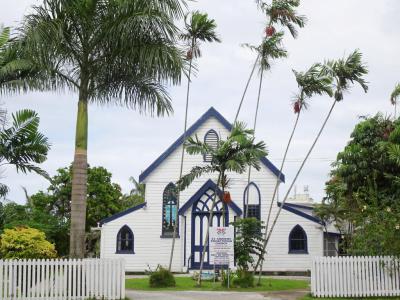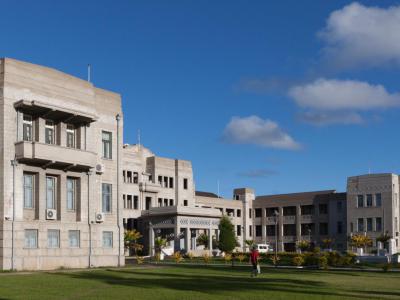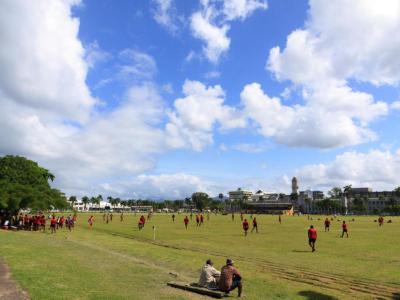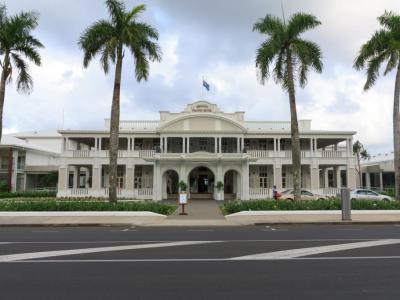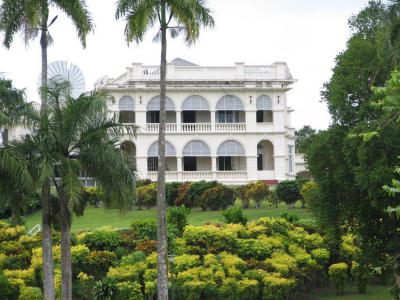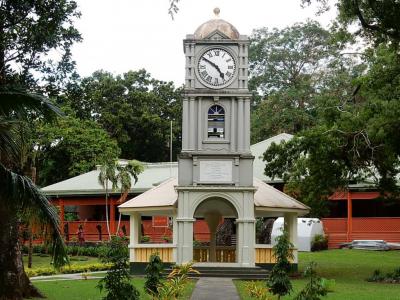Suva Introduction Walking Tour (Self Guided), Suva
Located on the southeast coast of Viti Levu, the main island of the Republic of Fiji, Suva is the country's largest metropolitan area and primary port. Serving as the nation's political, economic, and cultural hub, it also holds significance as the economic and cultural capital of the South Pacific.
Originally a small village, Suva's growth began with land granted to the Polynesia Company in 1868, though its plans for cotton farming faltered due to unsuitable conditions. The name "Suva" is derived from the Fijian word for "mound". In 1877, Suva became Fiji's capital, replacing in this capacity the town of Levuka on Ovalau Island. It gained municipality status in 1910 and city status in 1952, expanding its boundaries over time.
Today, Suva thrives as a center of arts, performance, and fashion, attracting visitors to its dynamic urban landscape. The city's skyline reflects its transformation, with sleek skyscrapers replacing colonial edifices. Yet, traces of its past still linger in quiet corners.
The Suva Municipal Market, a bustling hub of activity, showcases the vibrant colors and flavors of Fijian produce and culture. Meanwhile, the Curio & Handicraft Centre offers an opportunity to admire and purchase exquisite local handicrafts, reflecting the craftsmanship of the Fijian people.
Steeped in history, the city is home to many other landmarks such as the Ivi Triangle, a monument commemorating Fiji's indigenous heritage, Saint Andrew's Presbyterian Church, an enduring wooden edifice and one of Fiji's oldest, and the Ivi Triangle, the veritable heart of Suva's historical narrative.
Amongst other points of interest stand the art deco Regal Theater, the venerable Old Town Hall, the stately Grand Pacific Hotel and Government House, known for the towering "Bat Trees" that adorn its grounds, exuding elegance and charm.
For those seeking a tranquil retreat, Thurston Gardens and the Fiji Museum provide a serene escape, offering a fascinating insight into Fiji's natural and cultural history.
Equip yourself with comfortable shoes, ample water, and an umbrella, and allow our self-guided tour to guide you through Fiji's capital for a truly enjoyable experience filled with discovery and exploration. Suva eagerly awaits and is ready to captivate and inspire you!
Originally a small village, Suva's growth began with land granted to the Polynesia Company in 1868, though its plans for cotton farming faltered due to unsuitable conditions. The name "Suva" is derived from the Fijian word for "mound". In 1877, Suva became Fiji's capital, replacing in this capacity the town of Levuka on Ovalau Island. It gained municipality status in 1910 and city status in 1952, expanding its boundaries over time.
Today, Suva thrives as a center of arts, performance, and fashion, attracting visitors to its dynamic urban landscape. The city's skyline reflects its transformation, with sleek skyscrapers replacing colonial edifices. Yet, traces of its past still linger in quiet corners.
The Suva Municipal Market, a bustling hub of activity, showcases the vibrant colors and flavors of Fijian produce and culture. Meanwhile, the Curio & Handicraft Centre offers an opportunity to admire and purchase exquisite local handicrafts, reflecting the craftsmanship of the Fijian people.
Steeped in history, the city is home to many other landmarks such as the Ivi Triangle, a monument commemorating Fiji's indigenous heritage, Saint Andrew's Presbyterian Church, an enduring wooden edifice and one of Fiji's oldest, and the Ivi Triangle, the veritable heart of Suva's historical narrative.
Amongst other points of interest stand the art deco Regal Theater, the venerable Old Town Hall, the stately Grand Pacific Hotel and Government House, known for the towering "Bat Trees" that adorn its grounds, exuding elegance and charm.
For those seeking a tranquil retreat, Thurston Gardens and the Fiji Museum provide a serene escape, offering a fascinating insight into Fiji's natural and cultural history.
Equip yourself with comfortable shoes, ample water, and an umbrella, and allow our self-guided tour to guide you through Fiji's capital for a truly enjoyable experience filled with discovery and exploration. Suva eagerly awaits and is ready to captivate and inspire you!
How it works: Download the app "GPSmyCity: Walks in 1K+ Cities" from Apple App Store or Google Play Store to your mobile phone or tablet. The app turns your mobile device into a personal tour guide and its built-in GPS navigation functions guide you from one tour stop to next. The app works offline, so no data plan is needed when traveling abroad.
Suva Introduction Walking Tour Map
Guide Name: Suva Introduction Walking Tour
Guide Location: Fiji » Suva (See other walking tours in Suva)
Guide Type: Self-guided Walking Tour (Sightseeing)
# of Attractions: 14
Tour Duration: 2 Hour(s)
Travel Distance: 3.5 Km or 2.2 Miles
Author: ChristineS
Sight(s) Featured in This Guide:
Guide Location: Fiji » Suva (See other walking tours in Suva)
Guide Type: Self-guided Walking Tour (Sightseeing)
# of Attractions: 14
Tour Duration: 2 Hour(s)
Travel Distance: 3.5 Km or 2.2 Miles
Author: ChristineS
Sight(s) Featured in This Guide:
- Port of Suva
- Suva Municipal Market
- Curio & Handicraft Centre
- The Ivi Triangle
- Sacred Heart Cathedral
- Regal Theater
- Old Town Hall
- Suva City Carnegie Library
- St. Andrews Presbyterian Church
- Naiqaqi/Government Buildings
- Albert Park
- Grand Pacific Hotel
- Government House and the “Bat Trees”
- Thurston Gardens and Fiji Museum
1) Port of Suva
The Port of Suva, located along the south coast of Viti Levu in a protected harbor, is Fiji's largest and busiest international port. Serving a wide range of vessels, including passenger ships, container carriers, general cargo vessels, tankers, and diplomatic ships, it is equipped with comprehensive facilities and 24/7 operations to support its high volume of traffic.
Suva Port offers modern amenities such as deep berths, shore cranes, warehouses, and stream anchorage. It boasts robust border control measures with Customs and Biosecurity agencies operating within the port premises. The port’s pilotage services ensure smooth navigation for incoming and outgoing vessels, while its inner harbor turning basin accommodates ships up to 350 meters in length.
The Port of Suva has three berths with a 12-meter depth, handling up to 3,500 TEUs or handy-max vessels. King's Wharf, the central hub, spans 496 meters, with 300 meters as a modern quay and 195 meters on piles. The North Berth handles bunkering, while the South Berth provides extra fuel services.
Adjacent to King's Wharf, Walu Bay serves as a cross berth for vessels with drafts under 9 meters and beams under 28.5 meters, focusing on merchant ships. Princess Wharf, also operated by FPCL, caters primarily to fishing vessels and smaller regional ships.
The Port of Suva plays a vital role in Fiji's maritime activities, including the bunkering of vessels and the export of seafood. It handles a mix of naval and commercial traffic, with merchant ships prioritized at King's Wharf. The port's strategic facilities make it a key player in regional trade and transportation.
Suva Port offers modern amenities such as deep berths, shore cranes, warehouses, and stream anchorage. It boasts robust border control measures with Customs and Biosecurity agencies operating within the port premises. The port’s pilotage services ensure smooth navigation for incoming and outgoing vessels, while its inner harbor turning basin accommodates ships up to 350 meters in length.
The Port of Suva has three berths with a 12-meter depth, handling up to 3,500 TEUs or handy-max vessels. King's Wharf, the central hub, spans 496 meters, with 300 meters as a modern quay and 195 meters on piles. The North Berth handles bunkering, while the South Berth provides extra fuel services.
Adjacent to King's Wharf, Walu Bay serves as a cross berth for vessels with drafts under 9 meters and beams under 28.5 meters, focusing on merchant ships. Princess Wharf, also operated by FPCL, caters primarily to fishing vessels and smaller regional ships.
The Port of Suva plays a vital role in Fiji's maritime activities, including the bunkering of vessels and the export of seafood. It handles a mix of naval and commercial traffic, with merchant ships prioritized at King's Wharf. The port's strategic facilities make it a key player in regional trade and transportation.
2) Suva Municipal Market (must see)
Suva Municipal Market, situated near the wharf, stands as the largest and most vibrant market in the city, offering a rich tapestry of sights, sounds, and smells that make for an unforgettable experience. Open throughout the week, the market comes alive with bustling activity, with Thursday, Friday, and Saturday being particularly noteworthy for the influx of village farmers bringing their fresh produce into town.
Venturing into the Suva Municipal Market, one is immediately struck by its sheer size, housing hundreds of stalls piled high with a colorful array of produce. The market also features a second story, where kava, a traditional Fijian drink, can be found. Navigating the lanes requires a deft touch, as barrow-wielding vendors skillfully maneuver to deliver their goods.
The market boasts a diverse selection of produce, including familiar items like tomatoes, cabbages, and chillies, as well as more exotic offerings such as bitter gourds, jackfruit, dalo (taro), cassava, and yams. Prices are reasonable, often cheaper than supermarkets, and are clearly marked, eliminating the need for haggling.
Visiting Suva Municipal Market late in the day may limit the range of available food, but it presents an opportunity to discover bargains.
Venturing into the Suva Municipal Market, one is immediately struck by its sheer size, housing hundreds of stalls piled high with a colorful array of produce. The market also features a second story, where kava, a traditional Fijian drink, can be found. Navigating the lanes requires a deft touch, as barrow-wielding vendors skillfully maneuver to deliver their goods.
The market boasts a diverse selection of produce, including familiar items like tomatoes, cabbages, and chillies, as well as more exotic offerings such as bitter gourds, jackfruit, dalo (taro), cassava, and yams. Prices are reasonable, often cheaper than supermarkets, and are clearly marked, eliminating the need for haggling.
Visiting Suva Municipal Market late in the day may limit the range of available food, but it presents an opportunity to discover bargains.
3) Curio & Handicraft Centre
Nestled in Suva's Central Business District, the Suva Curio Handicraft Centre stands as a vibrant marketplace dedicated to promoting and showcasing the rich artistic heritage of Fiji. This center is a must-visit for those seeking an authentic encounter with Fijian culture through its handicrafts, carvings, and locally crafted jewelry.
The Curio Handicraft Centre offers an extensive array of Fijian and Indo-Fijian souvenirs. The diverse selection includes traditional items such as Kava Bowls, Grass Skirts, Tapa (Fijian Cloth), and Lali (Fijian Drum), each carrying the essence of Fijian culture.
The marketplace allows for an engaging shopping experience, where bargaining is acceptable. However, it is important to approach it with respect, considering the meticulous craftsmanship and time invested in creating these unique pieces.
The Curio Handicraft Centre offers an extensive array of Fijian and Indo-Fijian souvenirs. The diverse selection includes traditional items such as Kava Bowls, Grass Skirts, Tapa (Fijian Cloth), and Lali (Fijian Drum), each carrying the essence of Fijian culture.
The marketplace allows for an engaging shopping experience, where bargaining is acceptable. However, it is important to approach it with respect, considering the meticulous craftsmanship and time invested in creating these unique pieces.
4) The Ivi Triangle
The Ivi Triangle, with its park benches, has been a traditional meeting point. This triangular space has not only provided a tranquil spot for locals and visitors to take a break but also serves as a site with historical significance.
The focal point of the Ivi Triangle is the majestic ivi tree, also known as the Tahitian nut tree, under which a small plaque has been placed. While this monument seeks to commemorate Fiji's historical milestones, it's important to note that some of the information on the plaque is misleading.
The plaque mentions the arrival of early Wesleyan missionaries in 1835, which, in reality, occurred on the 12th of October, not the 14th as inscribed.
Additionally, the public land auction of 1880, noted on the monument, actually took place under a different Ivi tree near the Nubukalou creek, approximately 250 meters east of the triangle. Contrary to the plaque, Suva was not proclaimed the capital in 1882; European settlers declared Suva the capital in 1877, with the official move taking place in 1882 (or possibly 1881). However, the accurate historical fact on the plaque is the ceding of Fiji to Britain on the 10th of October, 1874.
The Ivi trees scattered across Suva serve as remnants of the original shoreline and act as markers for the earlier colonial settlement. Despite the discrepancies in historical information, the monument at the Ivi Triangle stands as a symbol attempting to memorialize key moments in Fiji's history, complemented by one of the city's few remaining Ivi trees.
The focal point of the Ivi Triangle is the majestic ivi tree, also known as the Tahitian nut tree, under which a small plaque has been placed. While this monument seeks to commemorate Fiji's historical milestones, it's important to note that some of the information on the plaque is misleading.
The plaque mentions the arrival of early Wesleyan missionaries in 1835, which, in reality, occurred on the 12th of October, not the 14th as inscribed.
Additionally, the public land auction of 1880, noted on the monument, actually took place under a different Ivi tree near the Nubukalou creek, approximately 250 meters east of the triangle. Contrary to the plaque, Suva was not proclaimed the capital in 1882; European settlers declared Suva the capital in 1877, with the official move taking place in 1882 (or possibly 1881). However, the accurate historical fact on the plaque is the ceding of Fiji to Britain on the 10th of October, 1874.
The Ivi trees scattered across Suva serve as remnants of the original shoreline and act as markers for the earlier colonial settlement. Despite the discrepancies in historical information, the monument at the Ivi Triangle stands as a symbol attempting to memorialize key moments in Fiji's history, complemented by one of the city's few remaining Ivi trees.
5) Sacred Heart Cathedral
Sacred Heart Cathedral stands proudly as the headquarters of the Catholic Archdiocese of Suva in Fiji. Its construction commenced in 1894, and the grand edifice was finally completed in 1994, marking 150 years since the arrival of the first Marist missionaries in Fiji. This cathedral, inspired by the churches of Rome, serves as the primary Roman Catholic Church in Fiji.
The cathedral's design reflects a grand European architectural style, featuring sandstone blocks imported from Australia. The structure boasts concrete staircases, balustrades and two towers contributing to its imposing presence.
The central focal point of the Sacred Heart Cathedral is a magnificent stained glass window positioned above the altar. This window captures attention with its depiction of a bilo cup beneath the Sacred Heart of Jesus, symbolizing spiritual and cultural significance.
Throughout its long history of construction and completion, the Sacred Heart Cathedral has become a prominent landmark in Suva.
The cathedral's design reflects a grand European architectural style, featuring sandstone blocks imported from Australia. The structure boasts concrete staircases, balustrades and two towers contributing to its imposing presence.
The central focal point of the Sacred Heart Cathedral is a magnificent stained glass window positioned above the altar. This window captures attention with its depiction of a bilo cup beneath the Sacred Heart of Jesus, symbolizing spiritual and cultural significance.
Throughout its long history of construction and completion, the Sacred Heart Cathedral has become a prominent landmark in Suva.
6) Regal Theater
The Regal Theater is an iconic structure that housed the original Regal cinema from the 1960s to the 1990s. The Theater building boasts an architectural style that seamlessly combines elements of art-deco and modernist design, echoing the trends popular in the US and Australia in the early 20th century.
The architecture of the Regal Theater is a visual delight, featuring vertical, zigzagged elements and rounded geometric art-deco features that define its exterior. The symmetrical front-facing facade is characterized by two bays, flanked by minimal elements, with the main decorative and centralized bay taking center stage. The balconies extending above the veranda at street level add to the building's distinctive charm.
While the Regal Theater was originally a cinematic hub, today the Regal Building has evolved to house modern retail spaces spanning two levels, complete with internal escalators.
The architecture of the Regal Theater is a visual delight, featuring vertical, zigzagged elements and rounded geometric art-deco features that define its exterior. The symmetrical front-facing facade is characterized by two bays, flanked by minimal elements, with the main decorative and centralized bay taking center stage. The balconies extending above the veranda at street level add to the building's distinctive charm.
While the Regal Theater was originally a cinematic hub, today the Regal Building has evolved to house modern retail spaces spanning two levels, complete with internal escalators.
7) Old Town Hall
Originally christened the Queen Victoria Memorial Hall upon its inauguration in 1905, the Old Town Hall holds echoes of a bygone era when it was situated opposite Fiji Air Services, encompassing a burial ground that transitioned from a local to a European resting place. All remains were later relocated to the existing Suva cemetery to pave the way for the construction of the initial Town Hall, which, for many years, claimed its position as Suva's premier architectural gem.
Distinguished by its balconies and ornate ironwork, the Town Hall exemplifies Suva's colonial architecture at its finest. Throughout its century-long existence, this venerable structure has served a multitude of purposes, housing entities like the Fiji Museum, an aquarium, a theater, and various restaurants.
Presently, it welcomes patrons to the Vineyard Palace Restaurant on the ground floor, exuding charm and heritage. Upstairs, the Old Town Hall finds new life with the Ashiyana Restaurant, an Indian culinary haven. The Ashiyana Restaurant specializes in authentic South Indian dishes reminiscent of those savored by the Moghul dynasty in the early 1800s. The restaurant offers a cozy and relaxed ambiance, inviting patrons to indulge in Tandoori curries.
Distinguished by its balconies and ornate ironwork, the Town Hall exemplifies Suva's colonial architecture at its finest. Throughout its century-long existence, this venerable structure has served a multitude of purposes, housing entities like the Fiji Museum, an aquarium, a theater, and various restaurants.
Presently, it welcomes patrons to the Vineyard Palace Restaurant on the ground floor, exuding charm and heritage. Upstairs, the Old Town Hall finds new life with the Ashiyana Restaurant, an Indian culinary haven. The Ashiyana Restaurant specializes in authentic South Indian dishes reminiscent of those savored by the Moghul dynasty in the early 1800s. The restaurant offers a cozy and relaxed ambiance, inviting patrons to indulge in Tandoori curries.
8) Suva City Carnegie Library
The Suva City Carnegie Library's inception traces back to 1907 when Andrew Carnegie extended a grant of 1500 pounds to the early Suva City Council. The only condition attached to Carnegie's offer was that the board provide a suitable site for the library and commit for its maintenance.
Officially inaugurated on November 24, 1909, by Governor Sir Everard Ferdinand im Thurn, the library received book donations from notable figures like Sir Alport Barker, the publisher of Fiji Times & Herald Limited. In the late 1920s, the Suva Town Board expanded the library by adding two substantial wings, each surpassing the size of the original structure.
During World War II, the library premises served a different purpose, hosting the American naval dental unit while the Carnegie books were safely stored away. The Suva Book Club persisted in temporary rooms. Post-war, both collections were reinstated in their original quarters, ultimately merging to form the Suva City Library.
An intriguing chapter in the library's history unfolded during its 100th Anniversary Celebration, with William Thomson, the great-grandson of Andrew Carnegie, gracing the occasion as a special guest.
Officially inaugurated on November 24, 1909, by Governor Sir Everard Ferdinand im Thurn, the library received book donations from notable figures like Sir Alport Barker, the publisher of Fiji Times & Herald Limited. In the late 1920s, the Suva Town Board expanded the library by adding two substantial wings, each surpassing the size of the original structure.
During World War II, the library premises served a different purpose, hosting the American naval dental unit while the Carnegie books were safely stored away. The Suva Book Club persisted in temporary rooms. Post-war, both collections were reinstated in their original quarters, ultimately merging to form the Suva City Library.
An intriguing chapter in the library's history unfolded during its 100th Anniversary Celebration, with William Thomson, the great-grandson of Andrew Carnegie, gracing the occasion as a special guest.
9) St. Andrews Presbyterian Church (must see)
Saint Andrew's Presbyterian Church is one of Suva's oldest surviving wooden structures. Distinguished by its white picket fence and juxtaposed against the towering concrete buildings that have emerged over the years.
The church's origins trace back to a pivotal meeting on January 16, 1883, where a small, self-appointed committee gathered in the Suva schoolhouse to deliberate the establishment of a Presbyterian place of worship in the town. In a remarkable eight months, on September 23, 1883, the inaugural service was held in the new church. Unfortunately, the original building fell victim to a cyclone that struck Suva on January 5, 1895.
Undeterred, the resilient congregation rallied to reconstruct, and by April 1895, the present wooden church graced Suva once again. Designated a Heritage Building by the National Trust of Fiji, Saint Andrew's is a cherished piece of Suva's architectural legacy.
A noteworthy addition to the church's history is the installation of its first pipe organ in 1908-a New Zealand craft organ commemorating the church's 25th anniversary. Costing 470 pounds, this musical treasure served the congregation for 80 years before restoration became necessary. In a unique decision, Saint Andrew's opted to retain a manual pipe organ, distinguishing itself from other churches in Suva.
Constructed entirely of wood, the church boasts a distinctive design reminiscent of rural churches abroad. Beyond its architectural significance, Saint Andrew's Presbyterian Church held a pivotal role in the social fabric of Suva, serving as a meeting and entertainment hub for the early European settlers in 1885.
The church's origins trace back to a pivotal meeting on January 16, 1883, where a small, self-appointed committee gathered in the Suva schoolhouse to deliberate the establishment of a Presbyterian place of worship in the town. In a remarkable eight months, on September 23, 1883, the inaugural service was held in the new church. Unfortunately, the original building fell victim to a cyclone that struck Suva on January 5, 1895.
Undeterred, the resilient congregation rallied to reconstruct, and by April 1895, the present wooden church graced Suva once again. Designated a Heritage Building by the National Trust of Fiji, Saint Andrew's is a cherished piece of Suva's architectural legacy.
A noteworthy addition to the church's history is the installation of its first pipe organ in 1908-a New Zealand craft organ commemorating the church's 25th anniversary. Costing 470 pounds, this musical treasure served the congregation for 80 years before restoration became necessary. In a unique decision, Saint Andrew's opted to retain a manual pipe organ, distinguishing itself from other churches in Suva.
Constructed entirely of wood, the church boasts a distinctive design reminiscent of rural churches abroad. Beyond its architectural significance, Saint Andrew's Presbyterian Church held a pivotal role in the social fabric of Suva, serving as a meeting and entertainment hub for the early European settlers in 1885.
10) Naiqaqi/Government Buildings
Naiqaqi, once a swampy area known as "The Crusher" for the nearby sugar mill, has evolved into the iconic Government Buildings that grace Victoria Parade in Suva. Prior to the construction of these impressive structures between 1937 and 1939, the land was inhabited by shacks, some of which served as houses of ill-repute.
The name Naiqaqi itself carries echoes of the sugar mill's presence, emphasizing its historical connection to the early industrial endeavors in Fiji. The first cane sugar mill in Fiji, established in 1872 by Brewster and Joske, stood near the current location of the Government Buildings.
Erected as the seat of the colonial administration, these Art Deco structures have become the nerve center of Fiji's executive wing. Currently, they house the offices of the Prime Minister of Fiji, the High Court, and various government ministries.
The architectural grandeur of the complex is complemented by two statues positioned prominently in front of the building.
The name Naiqaqi itself carries echoes of the sugar mill's presence, emphasizing its historical connection to the early industrial endeavors in Fiji. The first cane sugar mill in Fiji, established in 1872 by Brewster and Joske, stood near the current location of the Government Buildings.
Erected as the seat of the colonial administration, these Art Deco structures have become the nerve center of Fiji's executive wing. Currently, they house the offices of the Prime Minister of Fiji, the High Court, and various government ministries.
The architectural grandeur of the complex is complemented by two statues positioned prominently in front of the building.
11) Albert Park
Albert Park stands proudly opposite the Fijian Parliament House and government buildings. After undergoing a substantial $17 million redevelopment, the park was officially reopened in September 2016, solidifying its status as a significant cultural and recreational hub.
This iconic park serves as a multifunctional venue, playing host to crucial sporting events and serving as the epicenter for community gatherings such as Constitution Day celebrations and the Hibiscus Festival. The comprehensive refurbishment included the installation of four rugby and soccer grounds, two cricket fields, modern lighting, and the construction of a state-of-the-art 1000-seat grandstand, corporate lounges, and VIP rooms.
Albert Park holds a special place in aviation history, notably associated with Charles Kingsford-Smith's legendary trans-Pacific flight from Oakland, California to Brisbane, Australia in 1928. The park served as an emergency landing site for the Southern Cross. The plane left Oakland, California on May 31, 1928. After resting in Hawaii, the crew took off on the second leg to Suva, Fiji. The flight took 33 hours and 34 minutes, covering a distance of 3,144 miles (5,060 kilometers). On June 5, 1928, Southern Cross landed at Albert Park. It was the very first airplane to land at Fiji.
This iconic park serves as a multifunctional venue, playing host to crucial sporting events and serving as the epicenter for community gatherings such as Constitution Day celebrations and the Hibiscus Festival. The comprehensive refurbishment included the installation of four rugby and soccer grounds, two cricket fields, modern lighting, and the construction of a state-of-the-art 1000-seat grandstand, corporate lounges, and VIP rooms.
Albert Park holds a special place in aviation history, notably associated with Charles Kingsford-Smith's legendary trans-Pacific flight from Oakland, California to Brisbane, Australia in 1928. The park served as an emergency landing site for the Southern Cross. The plane left Oakland, California on May 31, 1928. After resting in Hawaii, the crew took off on the second leg to Suva, Fiji. The flight took 33 hours and 34 minutes, covering a distance of 3,144 miles (5,060 kilometers). On June 5, 1928, Southern Cross landed at Albert Park. It was the very first airplane to land at Fiji.
12) Grand Pacific Hotel (must see)
The Grand Pacific Hotel, Affectionately known as 'The Grand Old Lady' of Suva, is situated majestically on the main seafront along Victoria Parade. Meticulously crafted in 1914, it became an integral part of Fiji's colonial heritage. This iconic hotel emerged from the need for upscale accommodation in Suva to cater to South Pacific route passengers.
The construction culminated in the grand opening on 23rd May 1914. Characterized by high ceilings, expansive double-louvered doors, and a sweeping veranda, the design aimed to provide cool comfort and tropical style. The Grand Pacific Hotel features a grand entrance adorned with ornate columns, elegant balconies, and intricate details showcasing the craftsmanship of a bygone era.
Swiftly becoming the hub of colonial society in Suva, the hotel attracted not only tourists but also hosted official visits and grand balls commemorating significant events and distinguished visitors. In February 1915, the hotel welcomed former Australian Prime Minister Alfred Deakin.
The hotel played a role in aviation history when, on June 5, 1928, Sir Charles Kingsford Smith landed his plane in Albert Park near the hotel, completing the first trans-Pacific flight from the United States to Australia. A grand ball held next day celebrated this momentous achievement. In July 1929, the hotel hosted a reception for the crew of the German cruiser Emden and their commander, Lothar von Arnauld de la Perière, as part of their worldwide tour.
The construction culminated in the grand opening on 23rd May 1914. Characterized by high ceilings, expansive double-louvered doors, and a sweeping veranda, the design aimed to provide cool comfort and tropical style. The Grand Pacific Hotel features a grand entrance adorned with ornate columns, elegant balconies, and intricate details showcasing the craftsmanship of a bygone era.
Swiftly becoming the hub of colonial society in Suva, the hotel attracted not only tourists but also hosted official visits and grand balls commemorating significant events and distinguished visitors. In February 1915, the hotel welcomed former Australian Prime Minister Alfred Deakin.
The hotel played a role in aviation history when, on June 5, 1928, Sir Charles Kingsford Smith landed his plane in Albert Park near the hotel, completing the first trans-Pacific flight from the United States to Australia. A grand ball held next day celebrated this momentous achievement. In July 1929, the hotel hosted a reception for the crew of the German cruiser Emden and their commander, Lothar von Arnauld de la Perière, as part of their worldwide tour.
13) Government House and the “Bat Trees”
The Presidential Palace, commonly known as Government House, may not rival the grandeur of Buckingham Palace, but it stands as a significant icon in the city. Originally constructed in 1882, the palace underwent a reconstruction in 1928 after being struck by lightning in 1921. Reflecting the Georgian revival architectural style, Government House exhibits classic features such as symmetry and elegance.
The structural elements include verandas, Regency-style porticoes, pediments, decorative ornaments, parapets, and arched balconies. Influences from the Regency era are evident in the use of recesses around windows, creating shadows and dividing the facade into panels. Stucco serves as an exterior wall finish, contributing to the overall aesthetic. The roofs boast side-facing gables with eaves, completing the timeless charm of this historic residence.
Guarded by Fijian soldiers adorned in starched white sulus (sarongs) and red tunics, the residence serves as the official abode of Fiji's president. A lone guard stationed at the palace entrance undergoes a monthly exchange of duty, adding to the ceremonial nature of the surroundings.
Adjacent to Government House lies a natural spectacle known as the "Bat Trees." Positioned on the palace premises and visible from the road, these trees come to life at dusk when scores of fruit bats emerge. Parking on the seawalk side of the street, approximately 200 meters from the sentry, provides an ideal vantage point to witness these large, noisy creatures.
The structural elements include verandas, Regency-style porticoes, pediments, decorative ornaments, parapets, and arched balconies. Influences from the Regency era are evident in the use of recesses around windows, creating shadows and dividing the facade into panels. Stucco serves as an exterior wall finish, contributing to the overall aesthetic. The roofs boast side-facing gables with eaves, completing the timeless charm of this historic residence.
Guarded by Fijian soldiers adorned in starched white sulus (sarongs) and red tunics, the residence serves as the official abode of Fiji's president. A lone guard stationed at the palace entrance undergoes a monthly exchange of duty, adding to the ceremonial nature of the surroundings.
Adjacent to Government House lies a natural spectacle known as the "Bat Trees." Positioned on the palace premises and visible from the road, these trees come to life at dusk when scores of fruit bats emerge. Parking on the seawalk side of the street, approximately 200 meters from the sentry, provides an ideal vantage point to witness these large, noisy creatures.
14) Thurston Gardens and Fiji Museum (must see)
Thurston Gardens, originally known as Suva Botanical Gardens, were established in 1913 on the site of the original village of Suva. The gardens were later renamed in honor of Sir John Bates Thurston, Fiji's fifth Governor. The site holds profound historical significance, as it occupies the grounds where the original town of Suva stood before a tragic event in 1843. In that year, Suva witnessed one of the bloodiest fights in Fiji's history, resulting in the burning of the town. The aftermath saw many inhabitants killed and consumed by the people of Rewa.
A prominent feature within Thurston Gardens is the Clock Tower and bandstand, erected in 1918 as a memorial to Suva's first mayor.
Within the verdant embrace of Thurston Gardens, the Fiji Museum finds its home. The museum, established in 1955, occupies a building on the Botanical Garden grounds. It boasts a remarkable collection, including archaeological materials dating back an impressive 3,700 years.
The Fiji Museum is the overseer of Thurston Gardens. While some structures and artifacts may appear in need of attention, the gardens continue to be a cherished space for the people of Suva. During the day, locals frequent the gardens, taking in the beauty of various palms, gingers, water lilies, and other indigenous flora.
A prominent feature within Thurston Gardens is the Clock Tower and bandstand, erected in 1918 as a memorial to Suva's first mayor.
Within the verdant embrace of Thurston Gardens, the Fiji Museum finds its home. The museum, established in 1955, occupies a building on the Botanical Garden grounds. It boasts a remarkable collection, including archaeological materials dating back an impressive 3,700 years.
The Fiji Museum is the overseer of Thurston Gardens. While some structures and artifacts may appear in need of attention, the gardens continue to be a cherished space for the people of Suva. During the day, locals frequent the gardens, taking in the beauty of various palms, gingers, water lilies, and other indigenous flora.
The Most Popular Cities
/ view all
